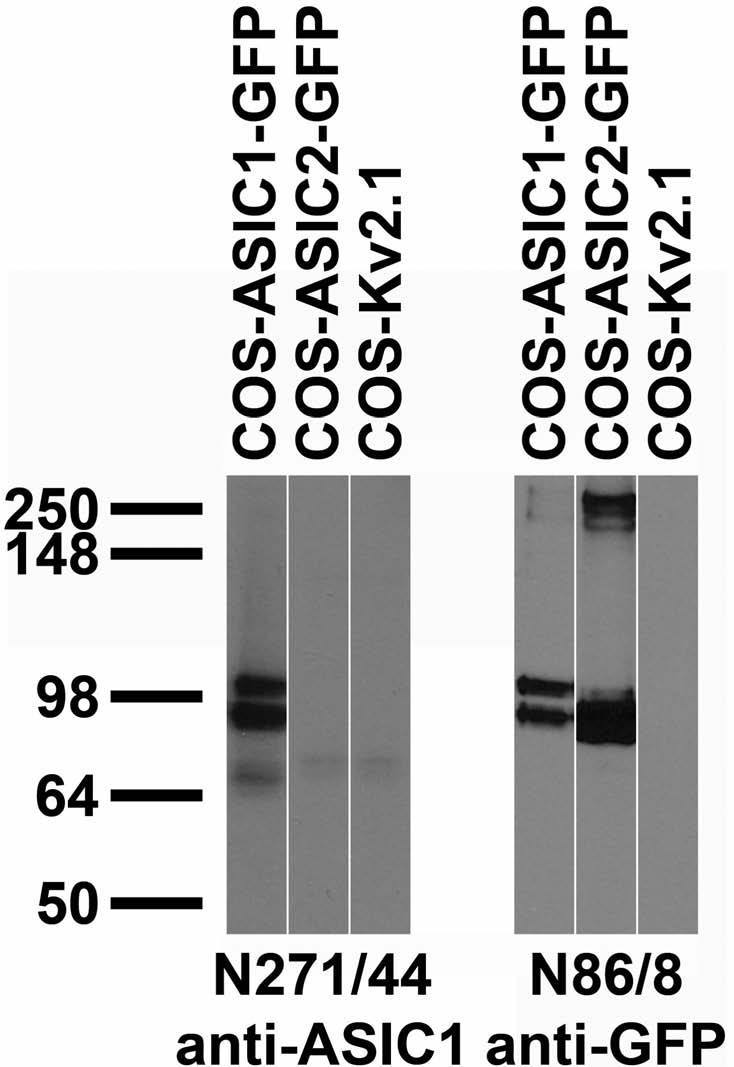Ships: 1-2 business days
Product Specific References for Applications and Species
| Immunohistochemistry: Mouse | ||
| PMID | Dilution | Publication |
| 32458389 | not listed | Yang, J., et al. 2020. Acid-Sensing Ion Channels Contribute to Type III Adenylyl Cyclase-Independent Acid Sensing of Mouse Olfactory Sensory Neurons. Molecular Neurobiology, 3042-3056. |
| 24788087 | 1:1000 | Vig, P.J., et al. 2014. Knockdown of acid-sensing ion channel 1a (ASIC1a) suppresses disease phenotype in SCA1 mouse model. Cerebellum, 479-190. |
| Immunoprecipitation: Human | ||
| PMID | Dilution | Publication |
| 34461722 | 1.5ul | Leisle, L., et al. 2021. Dynorphin Neuropeptides Decrease Apparent Proton Affinity of ASIC1a by Occluding the Acidic Pocket. Journal of Medicinal Chemistry, 13299-13311. |
| Western Blot: Human | ||
| PMID | Dilution | Publication |
| 34461722 | 1:1500 | Leisle, L., et al. 2021. Dynorphin Neuropeptides Decrease Apparent Proton Affinity of ASIC1a by Occluding the Acidic Pocket. Journal of Medicinal Chemistry, 13299-13311. |
| 34061161 | 1:1000 | Rook, M.L., et al. 2021. Mutation of a conserved glutamine residue does not abolish desensitization of acid-sensing ion channel 1. The Journal of General Physiology, . |
| 33986647 | 1:1000 | Neuhof, A., et al. 2021. Large Acid-Evoked Currents, Mediated by ASIC1a, Accompany Differentiation in Human Dopaminergic Neurons. Frontiers in Cellular Neuroscience, 668008. |
| 29057936 | not listed | Tian, Y., et al. 2017. Glioblastoma cancer stem cell lines express functional acid sensing ion channels ASIC1a and ASIC3. Scientific Reports, 13674. |
| 27941930 | not listed | Chen, B., et al. 2016. ERK-mediated NF-κB activation through ASIC1 in response to acidosis.. Oncogenesis, e279. |
| Western Blot: Mouse | ||
| PMID | Dilution | Publication |
| 29044528 | 1:100 | Farrag, M., et al. 2017. Endomorphins potentiate acid-sensing ion channel currents and enhance the lactic acid-mediated increase in arterial blood pressure: effects amplified in hindlimb ischaemia.. Journal of Physiology, 7167-7183. |
| Western Blot: Rat | ||
| PMID | Dilution | Publication |
| 37878364 | 1:100 | Anselmi, L, et al. 2023. Functional knockout of the TRPV1 channel has no effect on the exercise pressor reflex in rats. The Journal of Physiology, . |
| 31347922 | 1:30 | Kim, J.S., et al. 2019. Effect of knockout of the ASIC3 on cardiovascular reflexes arising from hindlimb muscle in decerebrated rats. American Journal of Physiology. Regulatory, Integrative, and Comparative Physiology, R641-R648. |
| 26492527 | 1:200 | Diochot, S., et al. 2016. Analgesic effects of mambalgin peptide inhibitors of acid-sensing ion channels in inflammatory and neuropathic pain. Pain, 552-559. |
| 23034652 | 1:300 | Diochot, S., et al. 2012. Black mamba venom peptides target acid-sensing ion channels to abolish pain.. Nature, 552-555. |






